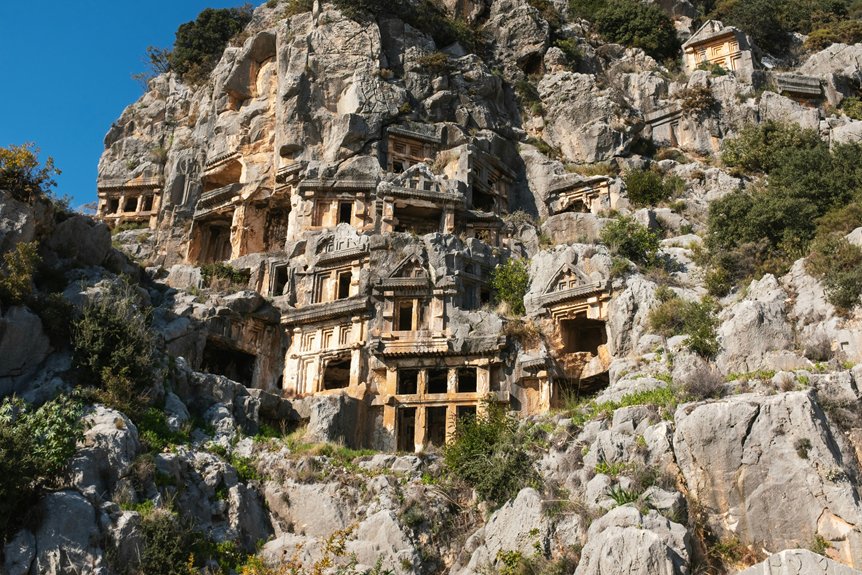You’ll find Hellenistic architecture dominates necropolis tombs due to extensive Mediterranean cultural exchange. Trade networks and population migrations facilitated architectural knowledge transmission, enabling wealthy families to showcase social prestige through sophisticated design. Rock-cut tombs strategically incorporated Greek architectural elements like intricate columns and mythological frescoes, transforming burial spaces into complex artistic statements. Explore further to uncover the nuanced dynamics behind these remarkable architectural innovations.
Key Takeaways
- Extensive trade networks and population migrations facilitated unprecedented cultural exchange, allowing Hellenistic architectural styles to spread rapidly across Mediterranean societies.
- Elite families used tomb architecture as a prestigious canvas to display economic resources and social standing, driving architectural innovation.
- Greek design principles offered sophisticated aesthetic and technical approaches to tomb construction, including intricate columns, detailed pediments, and complex spatial configurations.
- Cultural interactions during the Hellenistic period encouraged artistic hybridization, enabling local burial traditions to seamlessly integrate advanced Greek architectural techniques.
- Tomb designs served multiple purposes beyond burial, functioning as artistic statements that represented interconnected Mediterranean civilizations through complex architectural language.
Cultural Diffusion and Architectural Exchange
As archaeological evidence reveals, the Hellenistic period witnessed an unprecedented transmission of architectural knowledge and aesthetic principles across diverse Mediterranean societies. You’ll observe how the Paphos necropolis tombs exemplify this intricate cultural exchange, where Greek architectural styles were seamlessly integrated into local funerary practices.
The architectural styles you’ll encounter in these tombs demonstrate how Hellenistic design transcended geographical boundaries. Carved pillars, sophisticated vaulted ceilings, and intricate decorative friezes became visual languages that communicated cultural sophistication and interconnectedness. Trade networks, population migrations, and diplomatic exchanges facilitated this remarkable architectural diffusion, transforming tomb structures from mere burial spaces into complex artistic statements.
Rock-Cut Tomb Designs and Hellenistic Influences
While archaeological excavations continue to reveal the complexities of Hellenistic funerary architecture, rock-cut tomb designs stand as compelling testimonials to the profound Greek cultural influence across Mediterranean regions. You’ll observe that these subterranean structures meticulously emulated contemporary Greek architectural elements, incorporating intricate columns, detailed pediments, and sophisticated entablatures that transformed burial spaces into artistic statements.
You’ll notice the interior layouts mirrored Greek domestic and religious spatial configurations, featuring multiple chambers, strategically positioned benches, and carefully designed staircases. Naturalistic painting techniques further enhanced these tombs, with illusionistic depictions of architectural elements and mythological scenes reflecting advanced Hellenistic artistic trends.
In regions like Egypt and Asia Minor, these rock-cut tombs represented a nuanced cultural dialogue, blending local funerary traditions with Hellenistic architectural innovations. The widespread adoption of these designs across the Mediterranean basin demonstrates the extensive reach and transformative power of Hellenistic cultural exchange.
Artistic Decorative Techniques in Necropolis Construction
Although archaeological evidence consistently reveals the complexity of Hellenistic funerary art, the artistic decorative techniques employed in necropolis construction represent a sophisticated fusion of cultural aesthetic traditions. You’ll observe that tomb walls were meticulously adorned with vibrant frescoes depicting mythological scenes and daily life, utilizing naturalistic styles that demonstrated exceptional artistic skill.
You’ll notice the intricate architectural elements incorporated into tomb designs, including carved benches, staircases, and faux ceiling beams that reflected advanced Greek construction techniques. The volcanic tuff rock used in construction enabled intricate carving and multi-chambered burial structures with remarkable precision.
Decorative motifs like garlands, candelabras, and gorgon faces were strategically rendered on tomb walls, showcasing the nuanced artistic traditions of Hellenistic culture. Sarcophagi featured sculpted details such as mock pillows, further emphasizing the period’s commitment to aesthetic refinement and craftsmanship in commemorating the deceased.
Geographic Spread of Hellenistic Tomb Architectural Styles
The artistic sophistication evident in Hellenistic tomb decorative techniques extended far beyond localized cultural boundaries, revealing a complex network of architectural and artistic exchange throughout the Mediterranean region. You’ll observe that Hellenistic tomb architectural styles proliferated across diverse territories, including Cyprus, Anatolia, the Levant, and Egypt, demonstrating remarkable cultural interconnectedness.
As you examine these necropoleis, you’ll discover shared architectural features like rock-cut chambers, sculpted facades, and intricately decorated interiors. The diffusion wasn’t uniform but nuanced, with local artistic traditions blending seamlessly with Hellenistic influences. This dynamic interaction produced regional variations that reflected both universal design principles and distinct cultural identities.
The widespread adoption of these architectural styles underscores the extensive cultural exchange characteristic of the Hellenistic period. You’ll recognize that these tomb designs weren’t merely aesthetic choices but sophisticated expressions of interconnected Mediterranean civilizations, communicating complex social, religious, and artistic narratives through architectural language.
Socio-Economic Factors Driving Architectural Innovation
Socio-economic dynamics profoundly shaped the architectural innovation observed in Hellenistic necropolis tombs, revealing complex intersections between wealth, social status, and artistic expression. Wealthy individuals and elite families commissioned tombs as material representations of their economic resources and social standing, driving architectural sophistication and artistic complexity.
The patronage of skilled artisan workshops enabled intricate architectural designs that blended cultural traditions and demonstrated technical mastery. You’ll notice how tomb architecture became a canvas for displaying social prestige, with each architectural element strategically communicating familial prominence and economic capacity.
Cultural exchange during the Hellenistic period further catalyzed architectural innovation, as local traditions merged with Hellenistic design principles. Functional requirements for representing afterlife concepts and facilitating funerary rituals additionally influenced architectural choices. These socio-economic factors transformed necropolis tombs from mere burial spaces into elaborate statements of cultural identity, artistic achievement, and social hierarchy.
Frequently Asked Questions
What Are the Features of Hellenistic Architecture?
You’ll find Hellenistic architecture characterized by monumental, symmetrical structures featuring grand columns, intricate arches, and expansive domes. You’ll observe sophisticated proportions that blend natural and built environments, utilizing marble and limestone with elaborate decorative elements. You’ll notice these designs reflect cultural ambitions, showcasing intellectual complexity through architectural innovation that synthesizes regional styles into a cosmopolitan aesthetic of extraordinary visual sophistication.
What Does the Necropolis Symbolize?
Like whispers etched in stone, a necropolis symbolizes humanity’s profound dialogue with mortality. You’ll find these burial grounds represent more than mere resting places; they’re complex cultural landscapes reflecting societal beliefs about death, afterlife, and remembrance. They embody collective memory, social hierarchies, and spiritual cosmologies, transforming physical spaces into sacred repositories where individual and communal narratives of transcendence converge and are eternally preserved.
What Were the Features of the Hellenistic Period?
You’ll find the Hellenistic period was characterized by unprecedented cultural diffusion, architectural innovation, and artistic sophistication. You’ll observe significant developments in sculpture, urban planning, and intellectual pursuits. The era witnessed a remarkable blending of Greek traditions with local influences, resulting in complex artistic expressions. You’ll recognize this period as a transformative epoch marked by cosmopolitan cultural exchanges and dynamic intellectual creativity across the Mediterranean world.
What Is Considered the Most Significant Surviving Building of the Hellenic Period?
You’d be hard-pressed to find a more remarkable survivor than the Parthenon, which coincidentally stands as an enduring symbol/monument/tribute to architectural brilliance just as your curiosity peaks. This iconic temple on Athens’ Acropolis represents the pinnacle of Hellenic architectural achievement. Its Doric columns, precise geometric proportions, and sophisticated marble construction embody the era’s aesthetic ideals, demonstrating unparalleled craftsmanship and cultural sophistication that continue to inspire architects and historians alike.
Conclusion
As you explore the intricate layers of ancient necropolis architecture, you’ll discover how Hellenistic design transcended mere structural innovation. These tomb designs represent cultural bridges, weaving complex narratives of artistic exchange like intricate tapestries spanning civilizations. The architectural elements aren’t just stone and craft, but eloquent testimonies of human connectivity, revealing how societies transformed, adapted, and immortalized their collective cultural memories through monumental funerary expressions.

Meet Natalie, who has lived on Cyprus for the last 10 years. She loves exploring the beautiful nature of the island, like quiet forests and untouched beaches. Natalie has lots of cool experiences to share. Join her as she talks about her adventures in Cyprus.

